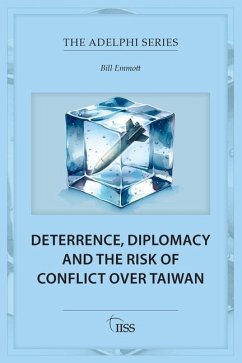Bill Emmott
Deterrence, Diplomacy and the Risk of Conflict Over Taiwan
Bill Emmott
Deterrence, Diplomacy and the Risk of Conflict Over Taiwan
- Broschiertes Buch
- Merkliste
- Auf die Merkliste
- Bewerten Bewerten
- Teilen
- Produkt teilen
- Produkterinnerung
- Produkterinnerung
In this Adelphi book, Bill Emmott evaluates the diplomatic and deterrence strategies that countries in and outside the Indo-Pacific region are using to try to reduce the risk of that conflict occurring. The goal must be for all sides to regard such a USâ China conflict as â inevitably catastrophic and therefore inconceivableâ .
Andere Kunden interessierten sich auch für
![New Answers to Old Questions New Answers to Old Questions]() Aaron ConnellyNew Answers to Old Questions30,99 €
Aaron ConnellyNew Answers to Old Questions30,99 €![Evaluating Japan's New Grand Strategy Evaluating Japan's New Grand Strategy]() Robert WardEvaluating Japan's New Grand Strategy36,99 €
Robert WardEvaluating Japan's New Grand Strategy36,99 €![The Taming of Scarcity and the Problems of Plenty The Taming of Scarcity and the Problems of Plenty]() Francis J. GavinThe Taming of Scarcity and the Problems of Plenty17,99 €
Francis J. GavinThe Taming of Scarcity and the Problems of Plenty17,99 €![The Responsibility to Defend The Responsibility to Defend]() Bastian GiegerichThe Responsibility to Defend33,99 €
Bastian GiegerichThe Responsibility to Defend33,99 €![Japan and the IISS Japan and the IISS]() Japan and the IISS52,99 €
Japan and the IISS52,99 €![Planning for Protraction Planning for Protraction]() Iskander RehmanPlanning for Protraction45,99 €
Iskander RehmanPlanning for Protraction45,99 €![Changing the Narrative Changing the Narrative]() Lawrence FreedmanChanging the Narrative21,99 €
Lawrence FreedmanChanging the Narrative21,99 €-
-
-
In this Adelphi book, Bill Emmott evaluates the diplomatic and deterrence strategies that countries in and outside the Indo-Pacific region are using to try to reduce the risk of that conflict occurring. The goal must be for all sides to regard such a USâ China conflict as â inevitably catastrophic and therefore inconceivableâ .
Produktdetails
- Produktdetails
- Adelphi series
- Verlag: Taylor & Francis Ltd
- Seitenzahl: 194
- Erscheinungstermin: 25. Juni 2024
- Englisch
- Abmessung: 234mm x 156mm x 11mm
- Gewicht: 366g
- ISBN-13: 9781032896335
- ISBN-10: 1032896337
- Artikelnr.: 70974967
- Herstellerkennzeichnung
- Libri GmbH
- Europaallee 1
- 36244 Bad Hersfeld
- gpsr@libri.de
- Adelphi series
- Verlag: Taylor & Francis Ltd
- Seitenzahl: 194
- Erscheinungstermin: 25. Juni 2024
- Englisch
- Abmessung: 234mm x 156mm x 11mm
- Gewicht: 366g
- ISBN-13: 9781032896335
- ISBN-10: 1032896337
- Artikelnr.: 70974967
- Herstellerkennzeichnung
- Libri GmbH
- Europaallee 1
- 36244 Bad Hersfeld
- gpsr@libri.de
Bill Emmott is Chairman of the IISS Trustees and an independent writer and consultant. He spent 26 years at The Economist, which he joined in 1980, working as a correspondent and editor in Brussels, Tokyo and London, on subjects ranging from politics to finance, economics and business. In 1993, he was appointed editor-in-chief, a post he held for 13 years before stepping down in 2006. He is Senior Adviser, Geopolitics for Montrose Associates, Chair of the Japan Society of the UK, an Ushioda Fellow of Tokyo College, University of Tokyo, Chair of the International Trade Institute, a trustee of the Chester Beatty Library, and a member of the Comitato Scientifico of the Centro Einaudi in Turin. He writes for La Stampa in Italy, Nikkei Business and the Mainichi Shimbun in Japan, and occasionally for the Financial Times. He is the author of numerous books on Japan, Asia, Italy and the West, his latest being The Fate of the West (Profile, 2017) and Japan's Far More Female Future: Increasing Gender Equality and Reducing Workplace Insecurity Will Make Japan Stronger (Oxford University Press, 2020).
Author
Acknowledgements
Map 1: Taiwan and its surrounding region
Introduction: Danger, hiding in plain sight
Chapter One: Why Indo-Pacific deterrence matters
Why the stakes in Taiwan are so high
The conflict to be deterred
Chapter Two: Deterrence lessons from Ukraine
Eight lessons from Ukraine
Specific implications for China
Specific implications for Taiwan
Specific implications for the United States
Chapter Three: Yardsticks for deterrence
A world in flux
Rationality without MADness
An unstable status quo
Yardsticks for Indo-Pacific deterrence
Chapter Four: Consistent America, inconstant America
Political will: consistency and clarity of deterrence messages
Military capability and coalition credibility
The narrative yardstick
Chapter Five: Taiwan and its predicament
Military resilience
Civil resilience
Narrative clarity
Chapter Six: Coercive China, deterrent China
Deterring an intervention
Controlling the nuclear risk
Controlling the narrative
Chapter Seven: Allies and partners: the role of Japan
Japan, from self-defence to constrained deterrence
Constrained but speedy?
Many unanswered questions
Chapter Eight: The Philippines, Australia and other partners
The Philippines as an unsinkable logistics centre
Australia: far away but now committed
Other allies and bystanders, near and far
ASEAN non-centrality
Limits to the ASEAN way
Dreaming of a more balanced region
Conclusion: Nostalgic for Cold War realism
Needed: the good aspect of Cold War diplomacy
Notes
Index
Acknowledgements
Map 1: Taiwan and its surrounding region
Introduction: Danger, hiding in plain sight
Chapter One: Why Indo-Pacific deterrence matters
Why the stakes in Taiwan are so high
The conflict to be deterred
Chapter Two: Deterrence lessons from Ukraine
Eight lessons from Ukraine
Specific implications for China
Specific implications for Taiwan
Specific implications for the United States
Chapter Three: Yardsticks for deterrence
A world in flux
Rationality without MADness
An unstable status quo
Yardsticks for Indo-Pacific deterrence
Chapter Four: Consistent America, inconstant America
Political will: consistency and clarity of deterrence messages
Military capability and coalition credibility
The narrative yardstick
Chapter Five: Taiwan and its predicament
Military resilience
Civil resilience
Narrative clarity
Chapter Six: Coercive China, deterrent China
Deterring an intervention
Controlling the nuclear risk
Controlling the narrative
Chapter Seven: Allies and partners: the role of Japan
Japan, from self-defence to constrained deterrence
Constrained but speedy?
Many unanswered questions
Chapter Eight: The Philippines, Australia and other partners
The Philippines as an unsinkable logistics centre
Australia: far away but now committed
Other allies and bystanders, near and far
ASEAN non-centrality
Limits to the ASEAN way
Dreaming of a more balanced region
Conclusion: Nostalgic for Cold War realism
Needed: the good aspect of Cold War diplomacy
Notes
Index
Author
Acknowledgements
Map 1: Taiwan and its surrounding region
Introduction: Danger, hiding in plain sight
Chapter One: Why Indo-Pacific deterrence matters
Why the stakes in Taiwan are so high
The conflict to be deterred
Chapter Two: Deterrence lessons from Ukraine
Eight lessons from Ukraine
Specific implications for China
Specific implications for Taiwan
Specific implications for the United States
Chapter Three: Yardsticks for deterrence
A world in flux
Rationality without MADness
An unstable status quo
Yardsticks for Indo-Pacific deterrence
Chapter Four: Consistent America, inconstant America
Political will: consistency and clarity of deterrence messages
Military capability and coalition credibility
The narrative yardstick
Chapter Five: Taiwan and its predicament
Military resilience
Civil resilience
Narrative clarity
Chapter Six: Coercive China, deterrent China
Deterring an intervention
Controlling the nuclear risk
Controlling the narrative
Chapter Seven: Allies and partners: the role of Japan
Japan, from self-defence to constrained deterrence
Constrained but speedy?
Many unanswered questions
Chapter Eight: The Philippines, Australia and other partners
The Philippines as an unsinkable logistics centre
Australia: far away but now committed
Other allies and bystanders, near and far
ASEAN non-centrality
Limits to the ASEAN way
Dreaming of a more balanced region
Conclusion: Nostalgic for Cold War realism
Needed: the good aspect of Cold War diplomacy
Notes
Index
Acknowledgements
Map 1: Taiwan and its surrounding region
Introduction: Danger, hiding in plain sight
Chapter One: Why Indo-Pacific deterrence matters
Why the stakes in Taiwan are so high
The conflict to be deterred
Chapter Two: Deterrence lessons from Ukraine
Eight lessons from Ukraine
Specific implications for China
Specific implications for Taiwan
Specific implications for the United States
Chapter Three: Yardsticks for deterrence
A world in flux
Rationality without MADness
An unstable status quo
Yardsticks for Indo-Pacific deterrence
Chapter Four: Consistent America, inconstant America
Political will: consistency and clarity of deterrence messages
Military capability and coalition credibility
The narrative yardstick
Chapter Five: Taiwan and its predicament
Military resilience
Civil resilience
Narrative clarity
Chapter Six: Coercive China, deterrent China
Deterring an intervention
Controlling the nuclear risk
Controlling the narrative
Chapter Seven: Allies and partners: the role of Japan
Japan, from self-defence to constrained deterrence
Constrained but speedy?
Many unanswered questions
Chapter Eight: The Philippines, Australia and other partners
The Philippines as an unsinkable logistics centre
Australia: far away but now committed
Other allies and bystanders, near and far
ASEAN non-centrality
Limits to the ASEAN way
Dreaming of a more balanced region
Conclusion: Nostalgic for Cold War realism
Needed: the good aspect of Cold War diplomacy
Notes
Index









